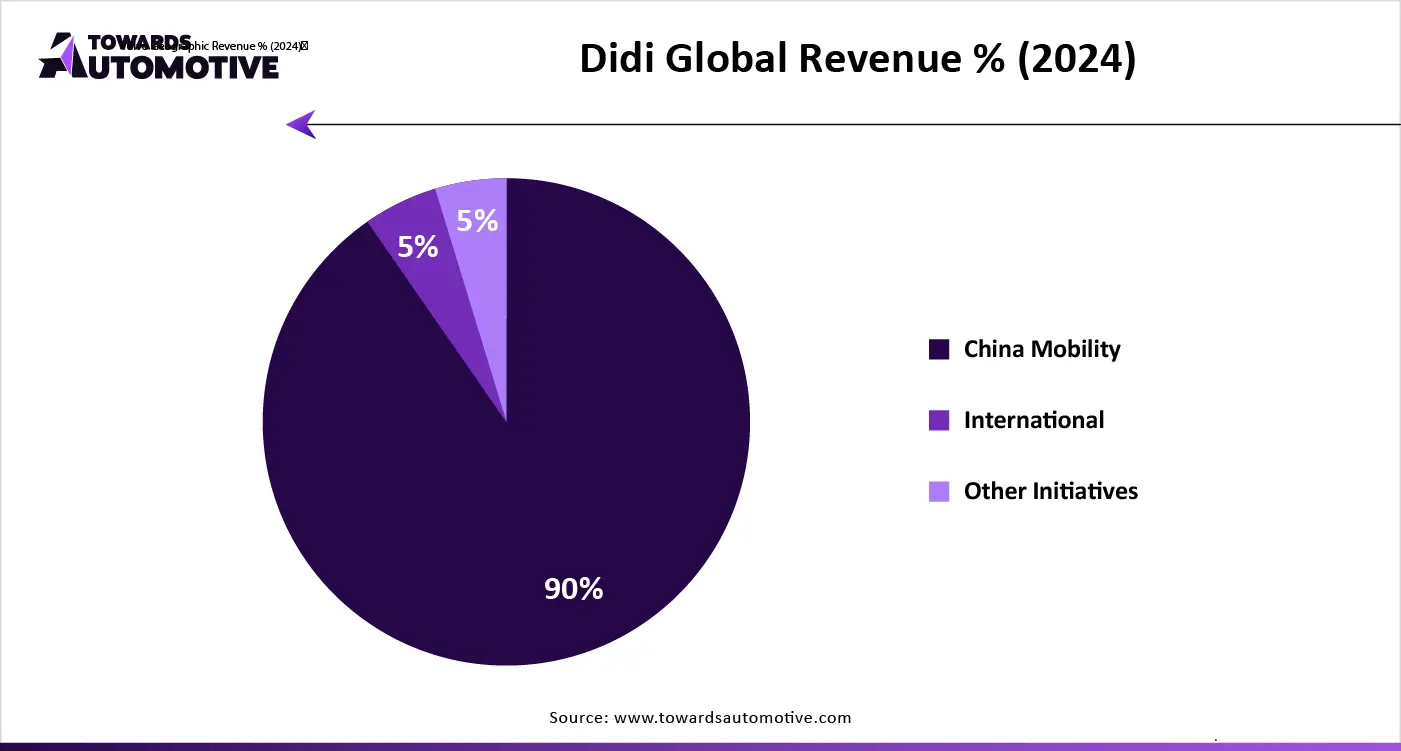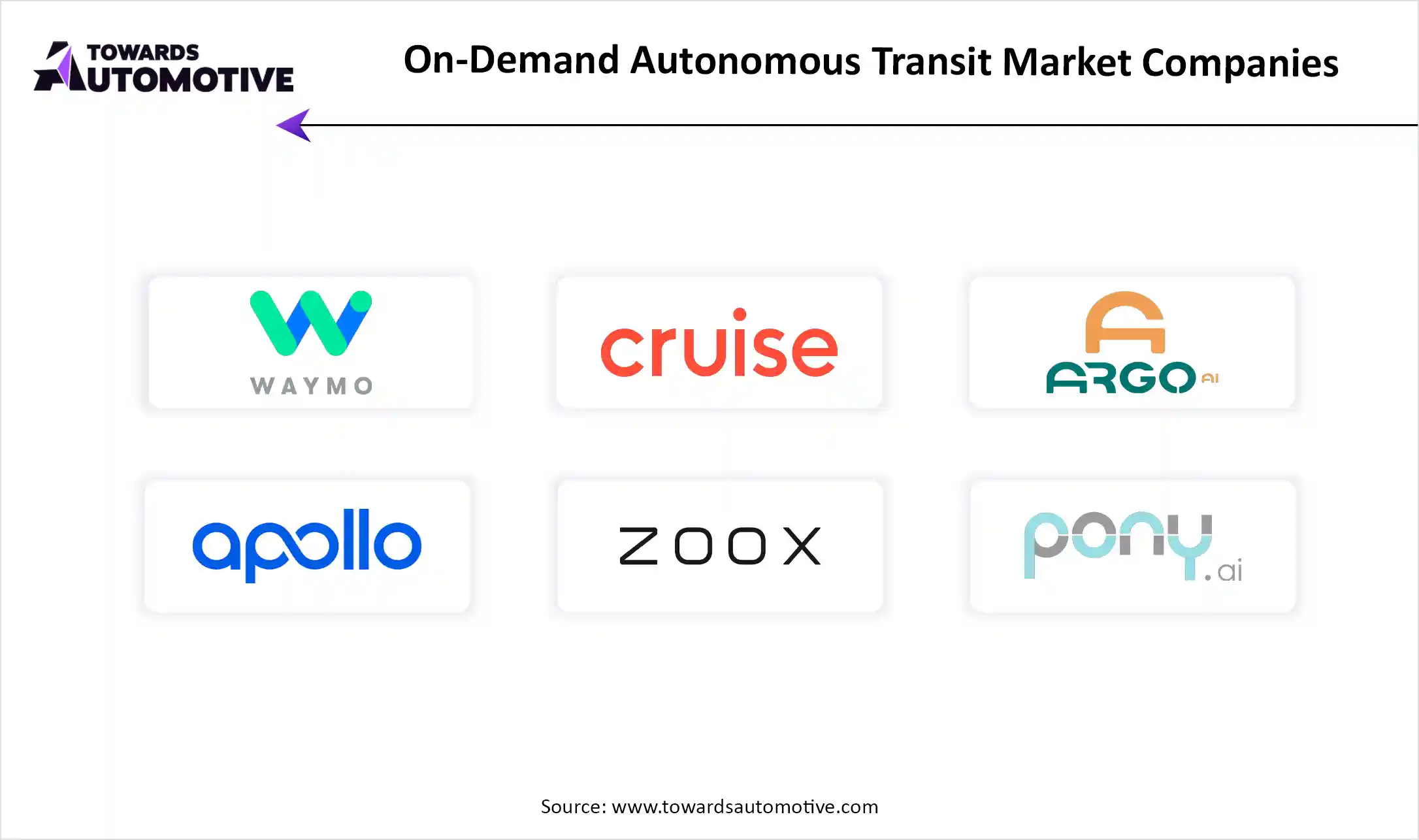October 2025
The on-demand autonomous transit market is accelerating, with forecasts predicting hundreds of millions in revenue growth between 2025 and 2034, powering sustainable infrastructure globally. The deployment of autonomous vehicles by fleet operators coupled with technological advancements in the automotive sector is playing a vital role in shaping the industrial landscape.
Moreover, the increasing popularity of MaaS in developed nations along with surge in demand for flexible and sustainable mobility solutions has boosted the market growth. The integration of AI in adaptive traffic management as well as rapid expansion of autonomous ride-hailing services is expected to create ample growth opportunities for the market players in the future.
The on-demand autonomous transit market is a prominent branch of the automotive industry. This industry deals in providing on-demand autonomous transit services across the world. There are several types of services provided by this sector consisting of autonomous ride-hailing, robot-shuttle/bus, autonomous delivery services, mobility as a service and some others. These services are operated using numerous types of vehicles comprising of passenger cars, shuttles/minibuses, vans/commercial vehicles and some others. It finds application in various sectors including urban mobility, campus mobility, airport shuttles, last-mile connectivity, logistics & delivery and some others. This market is expected to rise significantly with the growth of the e-commerce sector in different parts of the globe.
The major trends in this market consists of partnerships, advancements in V2X technology and deployment of robotaxis.
The passenger cars segment led the market with a share of 50%. The rapid deployment of autonomous sedans in developed nations to enhance the travelling experience of business professionals has boosted the market expansion. Additionally, technological advancements in ADAS coupled with integration of autonomous driving software in taxis is playing a prominent role in shaping the industrial landscape. Moreover, the rising investment by automotive brands for developing high-quality autonomous driving platform to cater the needs of passenger cars is expected to drive the growth of the on-demand autonomous transit market.
The shuttles/minibuses segment is expected to expand with the highest CAGR during the forecast period. The deployment of ADAS components in minibuses to enhance autonomous driving has boosted the market expansion. Additionally, partnerships among bus manufacturers and software companies to develop advanced autonomous driving platforms is playing a vital role in shaping the industry in a positive direction. Moreover, the deployment of autonomous shuttles by modern airports to enhance passenger transportation is expected to foster the growth of the on-demand autonomous transit market.
The robotaxi segment dominated the market with a share of 60%. The growing adoption of robotaxis for operating ride-hailing services has boosted the market expansion. Additionally, numerous government initiatives aimed at developing the road infrastructure along with rapid investment by fleet-operators to deploy robotaxis is crucial for the industrial expansion. Moreover, partnerships among automotive brands and ride-sharing companies to launch robotaxi services is expected to drive the growth of the on-demand autonomous transit market.
The autonomous delivery services segment is expected to rise with the fastest CAGR during the forecast period. The rising development in the e-commerce sector in different nations such as the U.S., China, India and some others has increased the demand for fast-delivery services, thereby driving the market expansion. Additionally, the integration of advanced autonomous driving systems in delivery vehicles to facilitate driverless delivery services is playing a vital role in shaping the industrial landscape. Moreover, collaborations among e-commerce companies and logistics providers to enhance autonomous delivery services is expected to boost the growth of the on-demand autonomous transit market.
The level 4 segment led the market with a share of 55%. The growing emphasis on deploying fully autonomous vehicles in fleet operations to reduce dependency on manual drivers has boosted the market growth. Additionally, continuous research and development related to level 4 autonomous driving systems is playing a prominent role in shaping the industrial landscape. Moreover, partnerships among automotive brands and software companies to develop advanced level 4 driving solutions is expected to propel the growth of the on-demand autonomous transit market.
The level 5 segment is expected to grow with the fastest CAGR during the forecast period. The increasing adoption for efficient transportation solutions has boosted the market expansion. Also, the growing demand for self-driving vehicles from airports and logistics sector to simplify complex operations is crucial for the industrial growth. Moreover, numerous advantages of level 5 autonomous vehicles including enhanced safety, increased mobility, superior convenience and some others is expected to boost the growth of the on-demand autonomous transit market.
The electric segment dominated the industry with a share of 80%. The growing adoption of electric vehicles by fleet operators to reduce vehicular emission has driven the market expansion. Additionally, numerous government initiatives aimed at rising awareness about EVs coupled with rapid investment by automotive brands to manufacture electrically-powered autonomous cars for commercial operations is shaping the industry in a positive direction. Moreover, partnerships among EV brands and fleet operators to deploy long-range EVs in fleet operations is expected to foster the growth of the on-demand autonomous transit market.
The hybrid segment is expected to grow with a significant CAGR during the forecast period. The increasing deployment of hybrid vehicles by ride-hailing companies to gain maximum profits has boosted the market growth. Additionally, rapid investment by automotive brands for developing powerful hybrid engines to cater the needs of fleet operators is crucial for the industrial landscape. Moreover, collaborations among automotive brands and ride-hailing brands is further contributing to the growth of the on-demand autonomous transit market.
The urban mobility segment held the largest share of the market with 70%. The rising urbanization in developed nations such as the U.S., Canada, Singapore, Germany and some others has boosted the market expansion. Additionally, the growing adoption of autonomous vehicles by ride-sharing companies in urban areas due to scarcity of manual drivers is playing a vital role in shaping the industry in a positive direction. Moreover, joint ventures among fleet operators and autonomous vehicle companies to deliver high-quality mobility services to urban dwellers is expected to drive the growth of the on-demand autonomous transit market.
The last-mile connectivity segment is expected to expand with the highest CAGR during the forecast period. The growing development in the e-commerce sector in several nations such as India, China, the U.S., and some others has driven the market growth. Additionally, the deployment of autonomous delivery vehicles by logistics providers to facilitate last-mile delivery services is contributing significantly to the industry. Moreover, partnerships among e-commerce companies and automotive brands for enhancing last-mile connectivity is expected to boost the growth of the on-demand autonomous transit market.
North America led the on-demand autonomous transit market with a share of 35%. The growing popularity of autonomous vehicles in the U.S. and Canada has boosted the market growth. Additionally, rise in number of autonomous ride-sharing companies coupled with rapid deployment of driverless vehicles in airports is playing a prominent role in shaping the industrial landscape. Moreover, the presence of numerous market players such as Waymo (Alphabet Inc.), Cruise LLC (General Motors), May Mobility and some others is expected to drive the growth of the on-demand autonomous transit market in this region.
U.S. dominated the market in this region. The rising development in the logistics sector coupled with rapid expansion of the V2X network has boosted the market expansion. Additionally, the growing investment by ride-hailing platforms to deploy autonomous vehicles for enhancing urban mobility is playing a vital role in shaping the industrial landscape.
Asia Pacific is expected to grow with the fastest CAGR during the forecast period. The rising adoption of autonomous cars in the e-commerce sector of several countries such as India, China, Singapore and some others has boosted the market expansion. Additionally, the development in the automotive software industry coupled with rapid deployment of robotaxis to enhance urban mobility is contributing to the industry in a positive direction. Moreover, the presence of several market players such as DiDi Autonomous Driving, Baidu Apollo, Pony.ai and some others is expected to boost the growth of the on-demand autonomous transit market in this region.
China is the major contributor in this region. The growing deployment of driverless vehicles by fleet operators to reduce dependency on manual drivers and enhancing safety has boosted the market growth. Additionally, technological advancements in the automotive sector coupled with rise in number of startup companies dealing in ride-sharing services is accelerating the industrial expansion.
The on-demand autonomous transit market is a highly competitive industry with the presence of several dominating players. Some of the prominent companies in this industry consists of Waymo (Alphabet Inc.), Cruise LLC (General Motors), Argo AI, Baidu Apollo, Zoox, Pony.ai, May Mobility, Optimus Ride, Motional, AutoX, DiDi Autonomous Driving, Aurora Innovation, Nuro, Mobileye (Intel subsidiary), Mercedes-Benz Group, Tesla, EasyMile, Navya, Local Motors and some others. These companies are constantly engaged in providing transportation services based on autonomous vehicles and adopting numerous strategies such as acquisitions, collaborations, business expansions, joint ventures, launches, partnerships, and some others to maintain their dominance in this industry.


By Autonomy Level
By Service Type
By Vehicle Type
By Propulsion Type
By Application Area
By Region
October 2025
October 2025
September 2025
July 2025
We offer automotive expertise for market projections and customizable research, adaptable to diverse strategic approaches.
Contact Us